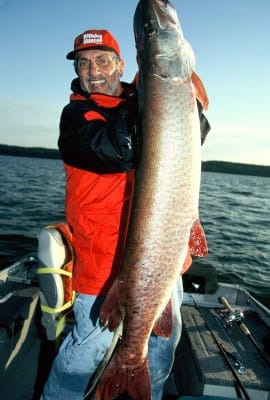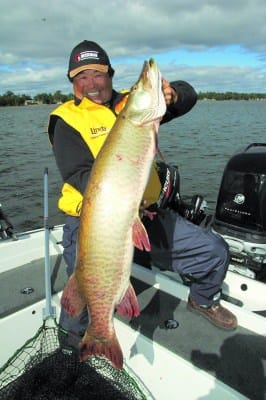
Catching oversize muskies isn’t easy anywhere, by anyone. But if you’re going to do it, autumn is the time, as the big toothy predators are on the prowl chowing down for the coming winter.
Huge muskies are caught with many different style and action lures. But in recent years hand-made, meticulously hand-painted “swim baits” have scored high. Such baits perfectly imitate choice muskie forage such as walleyes, perch, suckers and ciscos. Here are three hot ways to fish these remarkable lures for giant muskies.
1) Rock Reef Casting With Swim Baits – Noted Minnesota angler Ted Takasaki’s favorite late fall muskie tactic is casting “swim baits” over chunk-rock reefs as aquatic weeds die out. This is a weather-water transition period, and feeding muskies are looking for prey that has vacated weeds and headed to rocks for cover.
Ted prefers fishing rock reefs topping out 3 to 4 feet below the surface. He drifts with the wind, making long casts with the breeze. At times in blustery weather he uses a boat wind sock to slow his drift. Often a slow, tantalizing “swimming” bait retrieve triggers big fish best in unstable fall weather. But alternate swim bait retrieve tempos and speeds until fish strike.
A muskie crashing a big, fast-moving swim bait is a collision powerful enough to split the toe nails of some fishermen. And while big fish can hook themselves at the strike, it’s wise to make a hard solid hook set or two to drive big treble hooks home. Additionally, a powerful rod is needed to drive steel into a muskie maw. Most anglers use two-handed plug rods, most 6 to 7 feet line, with heavy braided line and top-quality steel leaders, snaps and swivels.
2) Inside Weed Edge Casting With Swim Baits – At times in muskieland, warm golden days of Indian summer occur, and that can be an outstanding opportunity to bust a big muskie, according to Chicago muskie ace Spence Petros. When air temperature rises well above water temperatures at such times, and while lake or river weed beds are still bright green in color, muskies commonly move to the “inside” edge of vegetation to chase forage fish. It’s a deadly set-up for casting lifelike swim baits that closely resemble perch, walleyes, suckers and other species.

Long casts that keep a lure right on a weed inside edge are good, with snappy, erratic retrieves often deadly.
As fall progresses, weed beds begin to die and turn brown. Some muskie men mistakenly give up fishing weed beds, and move toward other structures. This can be a huge mistake, says Spence, as muskies and their prey species seek the few remaining still-green weeds, where they can be concentrated and are comparatively easy to locate and catch.
3) “Snake” Trolling Two Swim Baits At Different Depths – No tactic works better at finding muskies and making them strike than trolling. And few lures are better for it than modern “swim baits.” But thoughtful trolling is required for best results.
Choice locations for trolling are food shelf areas where a drop-off edge is located – deep water on one side, shallower water on the other.
To troll drop-offs most effectively for muskies, use two lures: a shallow-running “swim bait” on the less deep side of a trolling boat, deeper-running lure on the opposite side. A swim bait with a diving lip can be used for depth work, or rigging a bullet-weight or dog-ear sinker ahead of the lure will take it down.
During trolling, maneuver a boat back-and-forth across the drop-off edge in a “snake” type boat system. This pulls lures through all areas of a structure where muskies may lurk looking for prey.
The Union Sportsmen’s Alliance website is designed to provide valuable articles about hunting, fishing and conservation for members of AFL-CIO affiliated labor unions and all sportsmen and sportswomen who appreciate hunting and fishing and want to preserve our outdoor heritage for future generations. If you would like your own story and experience from the outdoors to be considered for our website, please email us at[email protected].







